Miaplacidus, also known as Beta Carinae, is the second brightest star in the constellation of Carina, and the 29th brightest star in the night sky.
Key Facts & Summary
- Miaplacidus is an evolved giant star of spectral type A1 III, located at around 113.2 light-years / 34.7 parsecs away from the Sun.
- Miaplacidus has an apparent magnitude of 1.69 and an absolute magnitude of -1.03.
- The giant star has around 350% of the sun’s mass and around 680% of the sun’s radius.
- It is visible with the naked eye and has been known to us since the time of the ancients.
- Miaplacidus is the brightest star in the southern asterism known as the Diamond Cross. It marks the southwestern end of the famous asterism.
- Miaplacidus lies very near the planetary nebula designated as IC 2448, which is also located in the Carina constellation.
- Miaplacidus radiates a lot of energy, being around 288 times brighter than our sun.
- The star is also much hotter than our sun, with average surface temperatures estimated at around 8.866 K.
- Miaplacidus is quite a fast-spinning star, with an estimated rotational velocity of around 145.7 km / 90.5 mi per second.
- The star’s radial velocity has been observed and calculated to be at around -5.2 km / 3.2 mi per second.
- The surface gravity detected on Miaplacidus is at around 3.16 cgs.
- Miaplacidus is quite a young star, studies suggest that it has no more than 260 million years.
- The origin and meaning of the star’s name remained an enigma for many decades.
- Based on the star’s spectral type, its color has been determined to be bluish-white.
- The star doesn’t appear to have any companions or a circumstellar disk
Miaplacidus’s name remained a mystery for many decades. Its name made a historic debut on the star maps in the year 1856, when the star atlas Geography of the Heavens, composed by Elijah Hinsdale, was published.
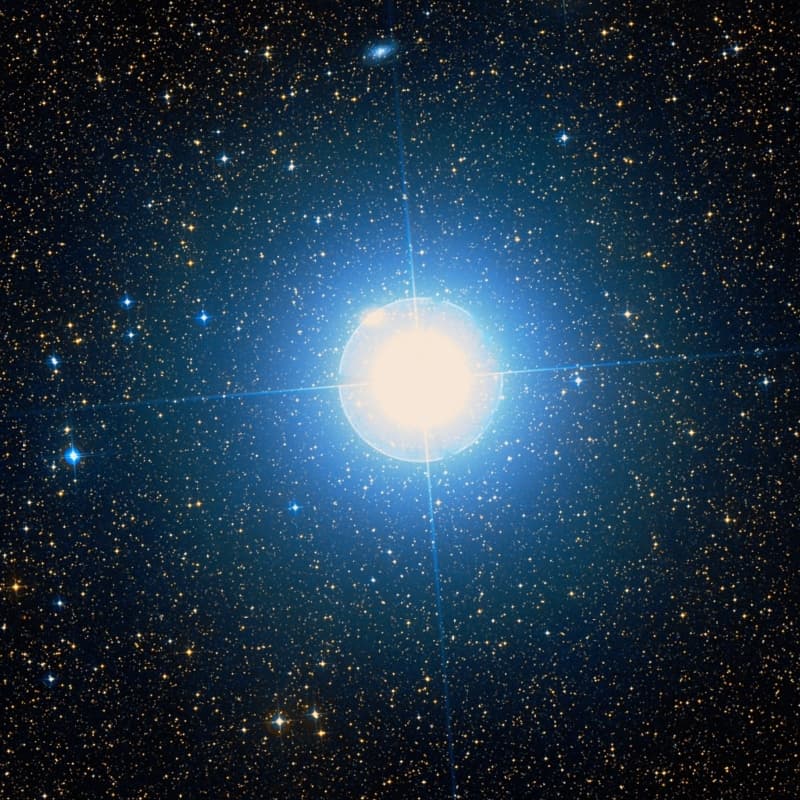
Many pondered upon the meaning and origin of the star’s name until William Higgins, a great scholar and an expert on star names, surmised the name Miaplacidus is actually a bilingual combination.
It is a combination of the Arabic word “miyah” – which translates to “waters”, and the Latin “placidus”, which translates to “placid.” The IAU finally released in 2016 a list of star names approved by the WGSN, and Miaplacidus was one such name.
Formation
Not too much is known about Miaplacidus’s formation. The star is quite young and it is estimated to have formed around 260 million years ago. It doesn’t seem as though it is associated with any group of moving stars. Miaplacidus most likely formed out of a molecular cloud rich in gas and dust. Gravity ultimately pulled the swirling gas and dust together to form the second brightest star of the Carina constellation, Miaplacidus.
Distance, Size, and Mass
Based on parallax measurements, Miaplacidus is at around 113.2 light-years / 34.7 parsecs away from the Sun. It is the 29th brightest star in the night sky, easily observable even with the unaided eye.
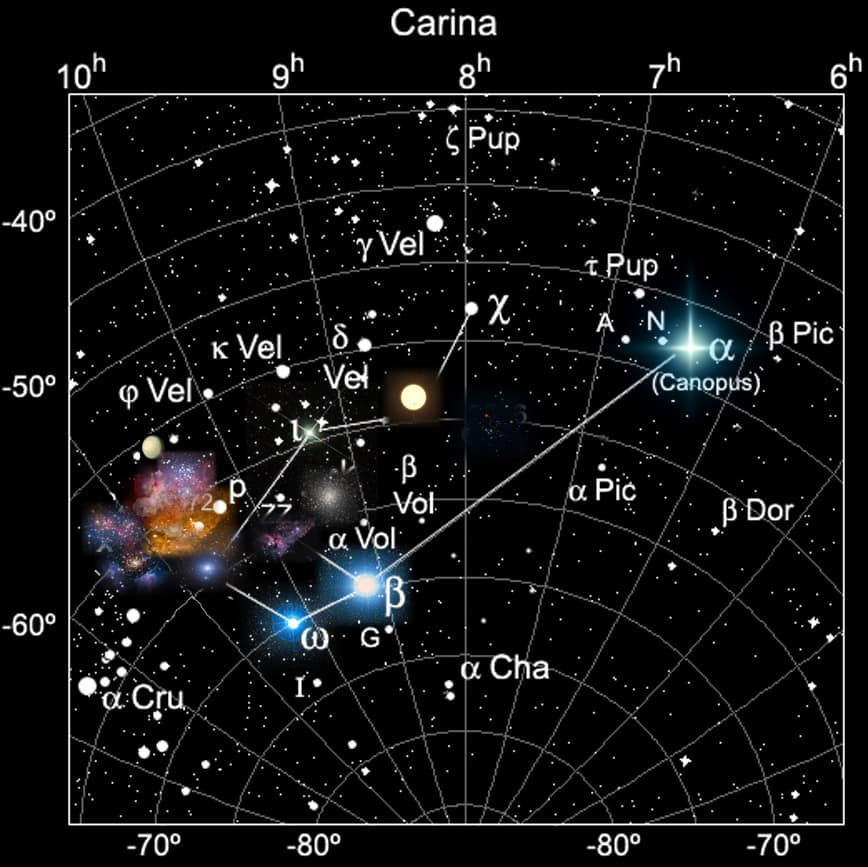
Miaplacidus is several times bigger than our sun. It has around 3.5 solar masses, or 350% of the sun’s mass, and an estimated 6.8 solar radii, or 680% of the sun’s radius. A star’s diameter is usually double its radius, as such, it is possible that Miaplacidus’s diameter is 13 times bigger than our sun’s.
Other Characteristics
Miaplacidus is an evolved bluish-white giant star of spectral type A1 III, it has an apparent magnitude of 1.69 and an absolute magnitude of -1.03. It is not suspected of being variable.
The star radiates a lot of energy, being around 288 times brighter than our sun. Miaplacidus is also much hotter than our sun, with average surface temperatures estimated at around 8.866 K. This is 1.5 times hotter than our sun.
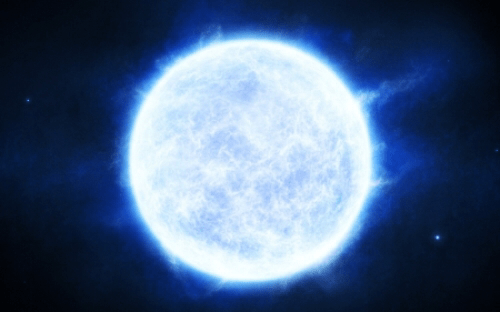
The star is also quite a fast-spinning star, with an estimated rotational velocity of around 145.7 km / 90.5 mi per second. The star’s radial velocity has been observed and calculated to be at around -5.2 km / 3.2 mi per second. Miaplacidus’s surface gravity has been estimated to be at around 3.16 cgs.
Location
Miaplacidus is located in the constellation of Carina, the celestial hull or keel of a ship. It is the second brightest star in the constellation after Canopus.
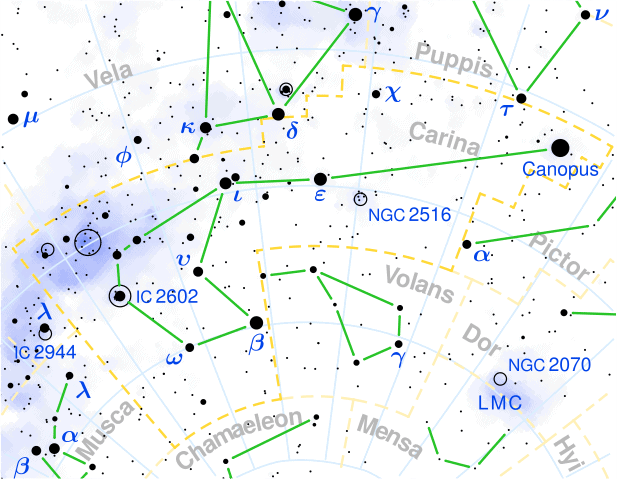
Carina was part of a larger constellation called the Argo Navis – this constellation represented the ship of Jason and the Argonauts. Canopus marked the ship’s keel. Though Canopus was the brightest star of Argo Navis, the constellation was later divided into three lesser constellations: Carina – the keel – Puppis – the stern – and Vela – the sails.
Miaplacidus lies very near the planetary nebula designated as IC 2448. Miaplacidus is also the brightest star in the southern asterism known as the Diamond Cross. It marks the southwestern end of the famous asterism. The stars that are part of this asterism are Beta Carinae, Upsilon Carinae, Omega Carinae, and Theta Carinae.
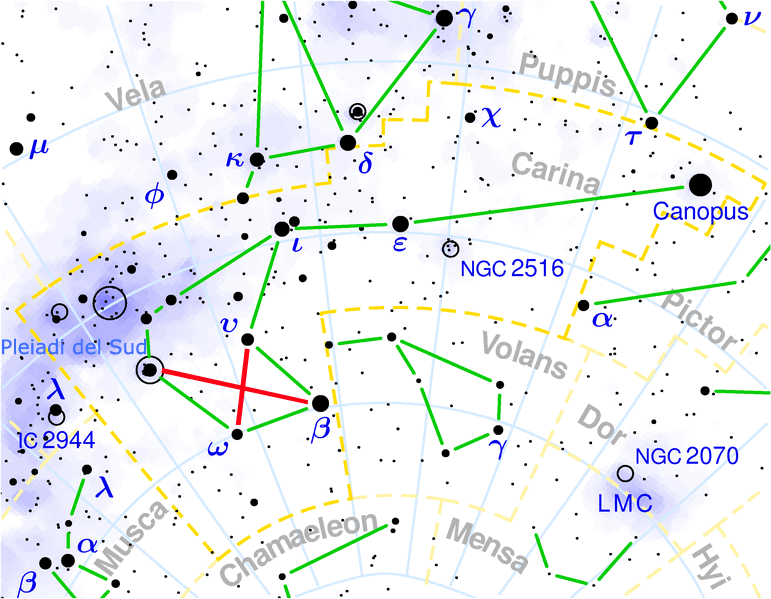
The constellation of Carina is in the southern sky, very near to the south celestial pole. Because of this, it never sets for most of the southern hemisphere observers. Due to the precession of Earth’s axis, by the year 4.700, the south celestial pole will be in the constellation of Carina.
The Future
Miaplacidus is an evolved blue-white giant star. When a star runs out of hydrogen, it begins to burn its helium thus it transforms into either a giant or supergiant star. Its core collapses as it gets hotter, resulting in the outer layer to expand outwards, such as in the case of Miaplacidus.
Stars that are either low or medium in mass evolved into red giants. Miaplacidus is massive enough to evolve into a red giant, but not massive enough to evolve into a supergiant. Blue giants usually last between 10 to 100 million years before they move to a different sequence.
Did you know?
- In Chinese, Miaplacidus is part of the “Nan Chuan” – meaning Southern Boat. It refers to an asterism consisting of Beta Carinae, V337 Carinae, PP Carinae, Theta Carinae and Omega Carinae.
- The Chinese name given for Miaplacidus is “Nan Chuan wu” which translates to the Fifth Star of Southern Boat.
- Miaplacidus lies in the Carina subdivision of Argo and is the alpha star of Halley’s Robur Carolinum – a constellation invented by Halley which died out after 50 years.
Sources:
Image source:
- https://upload.wikimedia.org/wikipedia/it/4/47/Miaplacidus.jpg
- https://ianavilches.files.wordpress.com/2015/05/acabado2.jpg?w=1400
- https://starcycleitaflores.weebly.com/uploads/5/8/5/9/58591825/635312268.png
- https://upload.wikimedia.org/wikipedia/commons/thumb/2/28/Carina_constellation_map.svg/617px-Carina_constellation_map.svg.png
- https://upload.wikimedia.org/wikipedia/commons/4/46/Diamond_cross.png
